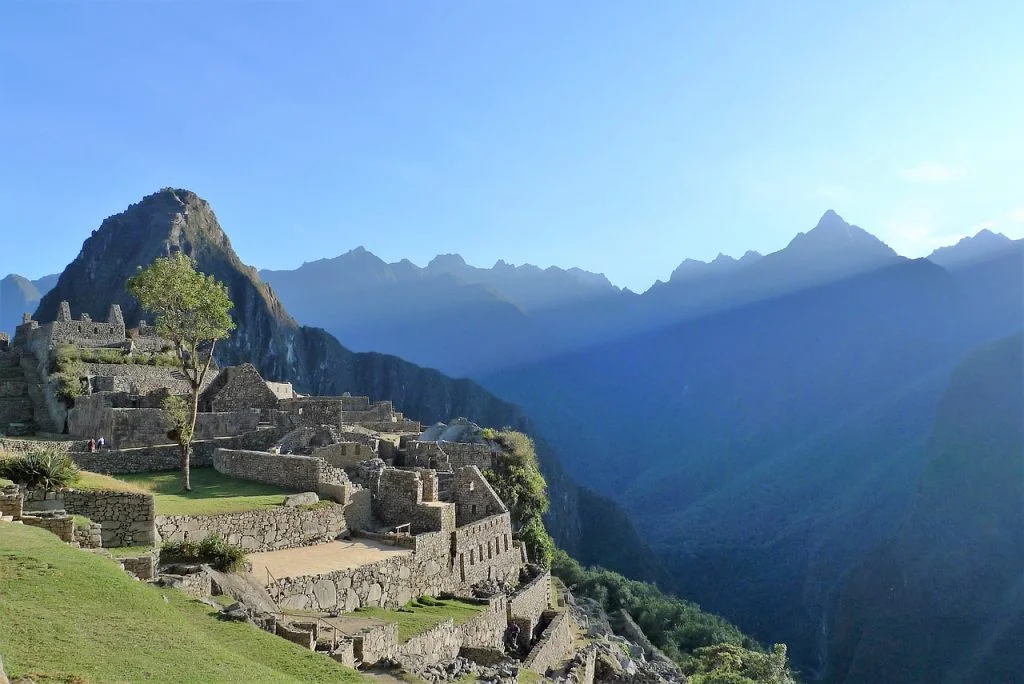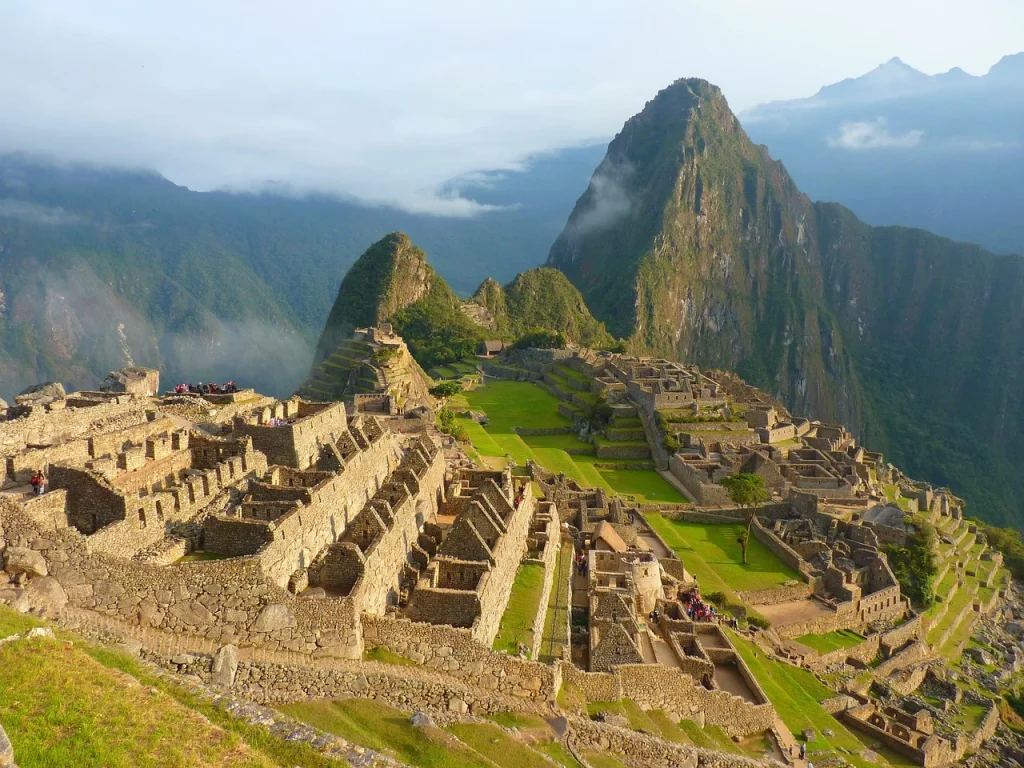Have you ever wondered what secrets lie hidden within the ancient stones of Machu Picchu? Perched high in the Andes, this mysterious city has been captivating travelers and historians alike with its enigmatic charm.
Imagine strolling through the remnants of a civilization where llamas are the local celebrities and the staircases lead to the clouds. Did the Incas have a thing for extreme hiking, or were they just trying to escape door-to-door salesmen? Let’s embark on a journey through 50 fascinating facts about this iconic wonder.
The most striking feature of Machu Picchu is its location.
Hiram Bingham
Machu Picchu Facts
Get ready to explore the wonders of Machu Picchu! As you dive into these intriguing facts, keep in mind that there’s a quiz at the end to see how much you’ve learned.
- Machu Picchu is an ancient Incan city in Peru.
- It was rediscovered in 1911 by Hiram Bingham, an American historian.
- The site is located at an elevation of about 2,430 meters (7,970 ft) above sea level.
- Machu Picchu means “Old Peak” or “Old Mountain” in the Quechua language.
- The city was built around 1450 AD, during the reign of Inca emperor Pachacuti.
- It’s believed to have been a royal estate or a religious retreat.
- The complex includes over 150 buildings, ranging from baths and houses to temples and sanctuaries.
- The Intihuatana stone is one of the many ritual stones in Machu Picchu. It was used for astronomical observations.
- Machu Picchu was an architectural marvel, with a sophisticated water supply system.
- The city was abandoned in the 16th century during the Spanish Conquest.
- The Incas used a technique called “ashlar” where stones are cut to fit together without mortar.
- Machu Picchu has been a UNESCO World Heritage Site since 1983.
- It’s also one of the New Seven Wonders of the World.

- The site spans over 32,592 hectares of mountain slopes, peaks, and valleys.
- The Temple of the Sun and the Room of the Three Windows are among its most famous structures.
- Over 60% of the construction is underground, as foundations or as crushed rock for drainage.
- The terraces at Machu Picchu were not only for agriculture but also to prevent landslides.
- Llamas and alpacas can often be seen grazing on the terraces.
- The site is divided into two main areas: the agricultural and the urban sector.
- The Sun Gate (Inti Punku) offers a spectacular view of the city from above.
- Machu Picchu was built in the classical Inca style, with polished dry-stone walls.
- The Temple of the Condor is thought to represent the Andean bird deity.
- The climate at Machu Picchu is generally warm and humid during the day and cool at night.
- The site was never discovered by the Spanish Conquistadors, remaining hidden in the mountains.
- Agricultural terraces called “andenes” surround the city.
- The construction of Machu Picchu is believed to have taken about 30 years.
- Granite was the primary material used for its buildings.
- The site is prone to threats like over-tourism and environmental degradation.

- The Inca Trail to Machu Picchu is a famous trekking route.
- It’s believed that only about 750 people lived in the city during its peak.
- The city’s design aligns with astronomical events, like the solstices and equinoxes.
- Water channels and fountains are spread throughout Machu Picchu.
- Machu Picchu’s isolation helped to preserve its cultural artifacts.
- The Wiñay Wayna site is an important part of the Inca Trail leading to Machu Picchu.
- Its location between two mountains has significant spiritual importance for the Incas.
- Archaeologists have identified several distinct sectors in the city, like the industrial, religious, and residential areas.
- The Central Plaza separates the agricultural and urban sectors.
- Rock quarries near Machu Picchu were likely the source for its construction materials.

- Human sacrifices may have been conducted at the site, according to some historians.
- The Temple of the Moon, located on a mountain near Machu Picchu, is another significant ceremonial area.
- Conservation efforts are crucial to maintain the integrity of Machu Picchu.
- Many of the artifacts found at Machu Picchu are now in Yale University’s Peabody Museum.
- The site attracts hundreds of thousands of tourists annually.
- Traditional Incan ceremonies are still performed at Machu Picchu.
- Erosion and landslides pose significant risks to the site’s stability.
- Orchids and other exotic flora are abundant in the Machu Picchu area.
- The Vilcanota River creates a natural barrier on one side of the site.
- Many structures in Machu Picchu remain unnamed, their original purposes unknown.
- The site was designed to be in harmony with the surrounding nature.
- Machu Picchu’s historical and cultural significance is a point of national pride for Peru.
Machu Picchu Myths

After traveling through all these epic facts about Machu Picchu, it’s time to unravel the truth behind some common myths. Let’s see what the actual truth is.
- The Lost City of the Inca
Machu Picchu was never really ‘lost‘. Local indigenous people knew about it, and it was rediscovered for the outside world by Hiram Bingham in 1911. - A City of Gold
Contrary to popular treasure tales, Machu Picchu was not a city of gold. It was more likely a ceremonial or astronomical site, rich in cultural, not material, wealth. - Built by Aliens
No extraterrestrial help here! Machu Picchu was an incredible feat of engineering by the Inca people, showcasing their advanced understanding of architecture and the natural environment. - An Isolated Place
Although it seems remote, Machu Picchu was part of a larger network of Inca trails and was likely an important link in the Inca empire. - Only Accessible by Foot
While many adventurers trek the Inca Trail, you can also reach Machu Picchu by train and a short bus ride, making it accessible for those not up for the hike.
No products found.
Machu Picchu Quotes

I plan to visit Machu Picchu in the next 5 years. But researching some quotes about the place made me feel a step closer to it. Let me know your favorite one in the comments.
Machu Picchu is a trip to the serenity of the soul, a symphony of stones.
Pablo Neruda
The Nobel Prize-winning poet Pablo Neruda reflects on the peaceful and harmonious nature of Machu Picchu.
Machu Picchu is the expression of the most sophisticated knowledge of engineering and astronomy.
Alberto Huaylla Huamán
Alberto Huaylla Huamán, a Peruvian engineer and researcher, highlights Machu Picchu’s advanced engineering and astronomical knowledge.
In the high solitude of these mountains, it’s easy to understand the impulse of the ancient builders.
Che Guevara
The revolutionary leader Che Guevara reflects on the inspiration and solitude found at the heights of Machu Picchu.
Every view from Machu Picchu is a study of beauty and power combined.
Mark Adams
Mark Adams, author of a popular book on Machu Picchu, speaks to the combination of natural beauty and architectural mastery at the site.
Machu Picchu is not only an architectural and engineering marvel but a place of great mystery and power.
Hugh Thomson
Hugh Thomson, a renowned explorer, and writer, emphasizes the mysterious and powerful aura of Machu Picchu beyond its architectural wonders.
Machu Picchu FAQ

I hope you enjoyed these quotes. Now it’s time for the final section before the quiz, which is the most asked question about Machu Picchu online. Read carefully.
- Is Machu Picchu a Wonder of the World?
Yes, Machu Picchu is indeed considered one of the New Seven Wonders of the World. This recognition was bestowed in 2007, highlighting its exceptional historical and architectural significance. As an ancient Incan city, it stands as a testament to the ingenuity and skill of the Inca civilization. - Can You Drive to Machu Picchu?
No, you cannot drive directly to Machu Picchu. The nearest you can get by car is to Aguas Calientes, the town below the ruins. From there, visitors typically take a short, scenic bus ride up the mountain. Alternatively, many choose the adventurous route by hiking the Inca Trail to reach the site. - How Was Machu Picchu Built?
Machu Picchu was built using a technique called “dry-stone wall construction.” The Incas meticulously cut stones to fit together tightly without the use of mortar. This precision, combined with their understanding of astronomy and engineering, allowed them to create this enduring and harmonious structure with the natural landscape. - What Did Machu Picchu Used to Look Like?
Originally, Machu Picchu would have been a vibrant, lively place. The buildings were likely covered in brightly colored plasters, and the terraces would have been used for agriculture. Over time, the site was reclaimed by the jungle, leaving the iconic gray stone ruins we see today. - Is Machu Picchu in the Andes?
Yes, Machu Picchu is located in the Andes Mountains of Peru. It sits at an impressive altitude of about 2,430 meters (7,970 feet) above sea level. This high-altitude location contributes to its breathtaking views and its reputation as the “Lost City of the Incas.”
No products found.
Machu Picchu Trivia

Welcome to the ultimate Machu Picchu challenge! If you fail to answer correctly, beware – you might just find a llama following you home to remind you of your quiz blunders!
Conclusion
As we conclude our journey through the enigmatic world of Machu Picchu, let’s take a moment to appreciate the real unsung hero: stairs. There are lots and lots of stairs. If the Incas had invented the StairMaster, they would’ve been way ahead of their time. Imagine the fitness levels!
These ruins aren’t just a testament to Incan ingenuity but also to their calf muscles. So, next time you skip the elevator for the stairs, ask yourself, ‘Am I Machu Picchu ready?’ Your calves may scream ‘no,’ but your heart says’maybe someday.’
10 Sources Used For This ArticleAmazing Facts About Machu Picchu – Altitude Experience
Machu Picchu – History
21 Interesting Facts about Machu Picchu – Metro Journeys
Machu Picchu – Unknown World
Machu Picchu Facts – Fascinating Information About Machu Picchu – Machu Picchu Trek
25 Interesting Machu Picchu Facts You Should Know – Machu Travel Peru
Machu Picchu – Peru – Rail Pass
50 Unveiled Secrets: The Intriguing History of Machu Picchu – 2024 – At Once
16 Things to KNOW Before Visiting Machu Picchu, Peru – Destination Less Travel


